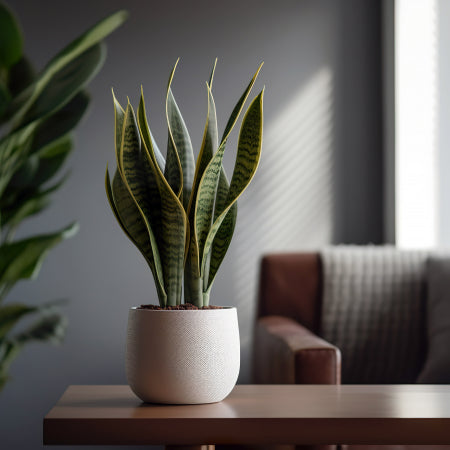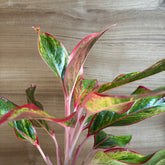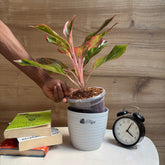Tips to Grow and Care Snake Plant
Dracaena trifasciata, is a flowering plant in the Asparagaceae family that is endemic to tropical West Africa, stretching from Nigeria to Congo. It goes by a variety of names, including snake plant, Saint George’s sword, mother-in-law’s tongue, and viper’s bowstring hemp. Until 2017, it was known as Sansevieria trifasciata.This plant is commonly kept as a houseplant due to its low maintenance requirements; it can live with little water and sunlight.
Quick Facts of snake plant
A quick overview of mother-in-law’s tongue:
|
Fact |
Description |
||||||||||||||||||||||
|
Scientific Name |
Sansevieria trifasciata, Dracaena trifasciata |
||||||||||||||||||||||
|
Common Names |
Snake plant, Mother-in-law’s tongue, Saint George’s sword, viper’s bowstring hemp |
||||||||||||||||||||||
|
Origin |
West Africa |
||||||||||||||||||||||
|
Appearance |
Tall, upright leaves with variegated patterns |
||||||||||||||||||||||
|
Light Requirements |
Indirect sunlight to low light conditions |
||||||||||||||||||||||
|
Temperature Tolerance |
Moderate, between 60°F to 85°F (15°C to 29°C) |
||||||||||||||||||||||
|
Watering Frequency |
Allow soil to dry completely between waterings |
||||||||||||||||||||||
|
Soil Type |
Well-draining potting mix for succulents |
||||||||||||||||||||||
|
Fertilizing |
Balanced liquid fertilizer diluted monthly |
||||||||||||||||||||||
|
Propagation Methods |
Leaf cuttings or division of rhizomes |
||||||||||||||||||||||
|
Air Purifying Qualities |
Removes toxins like formaldehyde and benzene |
||||||||||||||||||||||
|
Low-Maintenance |
Thrives with minimal care
Growing and caring for a snake plant (Sansevieria trifasciata) is relatively easy, making it an excellent choice for both novice and experienced plant enthusiasts. Here’s a detailed guide on how to grow and care for a snake plant: Tips to Care and Grow Snake PlantLight Requirements:Snake plants grow best with 8 to 10 hours of indirect sunlight or a few hours of early-morning direct sunlight. Snake plants thrive in indirect sunlight but can tolerate low light conditions. Place your plant near a bright, filtered light source, such as a north or east-facing window. Avoid direct sunlight, as it can cause leaf burn. However, snake plants can adapt to low light conditions, making them suitable for offices or rooms with minimal natural light. Temperature and Humidity:Snake plants prefer moderate temperatures ranging from 60°F to 85°F (15°C to 29°C). They can tolerate temperature fluctuations but should be protected from cold drafts and extreme heat. Average indoor humidity levels are usually sufficient for snake plants, but they can tolerate low humidity environments. Watering:One of the most crucial aspects of snake plant care is proper watering. Allow the soil to dry out completely between waterings, as snake plants are susceptible to root rot from overwatering. Stick your finger into the soil about an inch deep; if it feels dry, it’s time to water. Water the plant thoroughly, allowing excess water to drain out of the pot. Reduce watering frequency during the winter months when the plant’s growth slows down.Keep in mind that overwatering is the quickest way to kill a snake plant. Too much water or letting the plant sit in water will rot its root system. Yellowing leaves are an early sign of overwatering. Soil and Potting:Use a well-draining potting mix specifically formulated for succulents or cacti. A mixture of potting soil, sand, and perlite works well for snake plants. Ensure the pot has drainage holes to prevent waterlogging, which can lead to root rot. Repot your snake plant into a slightly larger container every two to three years or when it outgrows its current pot. Fertilizing:Snake plants are relatively low-maintenance and don’t require frequent fertilization. Feed your snake plant with a balanced liquid fertilizer diluted to half strength during the growing season (spring and summer) once a month. Avoid over-fertilizing, as this can lead to fertilizer burn and damage the plant. Feed your snake plant once in spring and once in mid-summer with a balanced, slow-release 10-10-10 fertilizer diluted to half strength. Do not fertilize in winter. Pruning and Maintenance:Trim any dead, yellowing, or damaged leaves using clean, sharp scissors or pruning shears. This helps maintain the plant’s appearance and encourages new growth. Wipe the leaves with a damp cloth to remove dust and keep them looking vibrant. Propagation:Expand your snake plant collection by propagating new plants from leaf cuttings or division of rhizomes. To propagate from leaf cuttings, cut a healthy leaf into several sections and plant them in moist potting mix. Keep the soil consistently moist until new shoots emerge. For division, carefully separate the rhizomes and plant them in individual pots with fresh potting mix. Pest Control:Monitor your snake plant for signs of pests such as spider mites, mealybugs, or scale insects. If detected, treat infestations promptly with insecticidal soap or neem oil. Isolate the affected plant to prevent spreading to other plants. Seasonal Care:During the winter months, reduce watering frequency and avoid placing the plant near cold drafts or heating vents. If your snake plant is situated near a window, protect it from cold temperatures by placing a barrier between the plant and the window. You should repot a snake plant every 3 to 5 years.
With the right care and attention, your snake plant will repay you with its beauty and durability, making it a treasured addition to your indoor garden. Contact LittleJungle for the best Snake Plants. |







